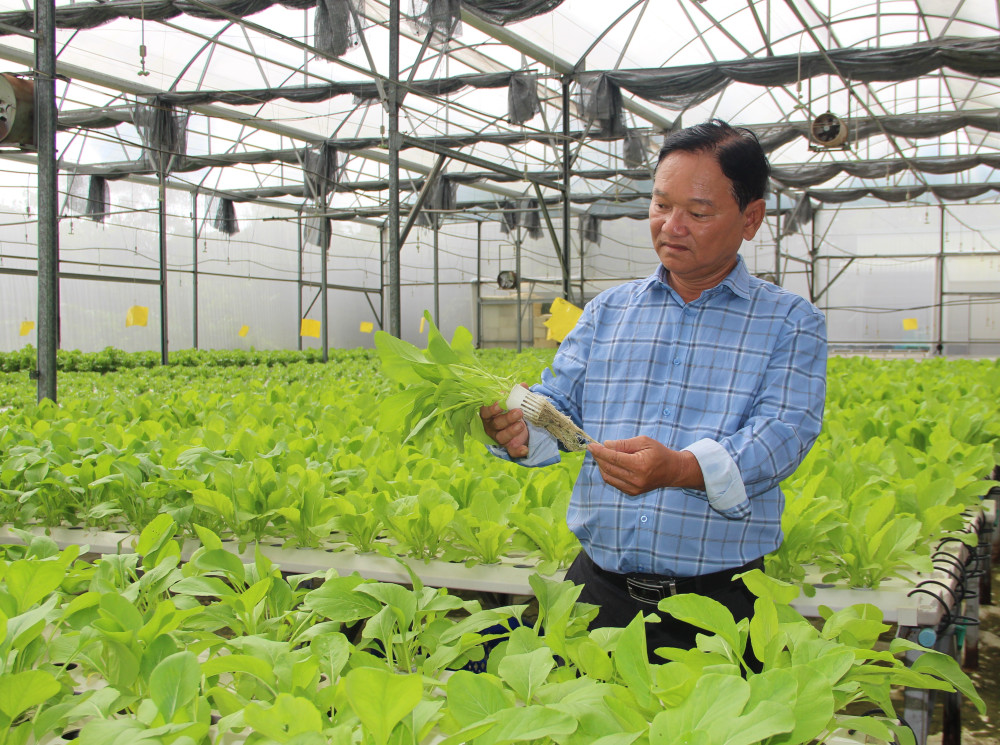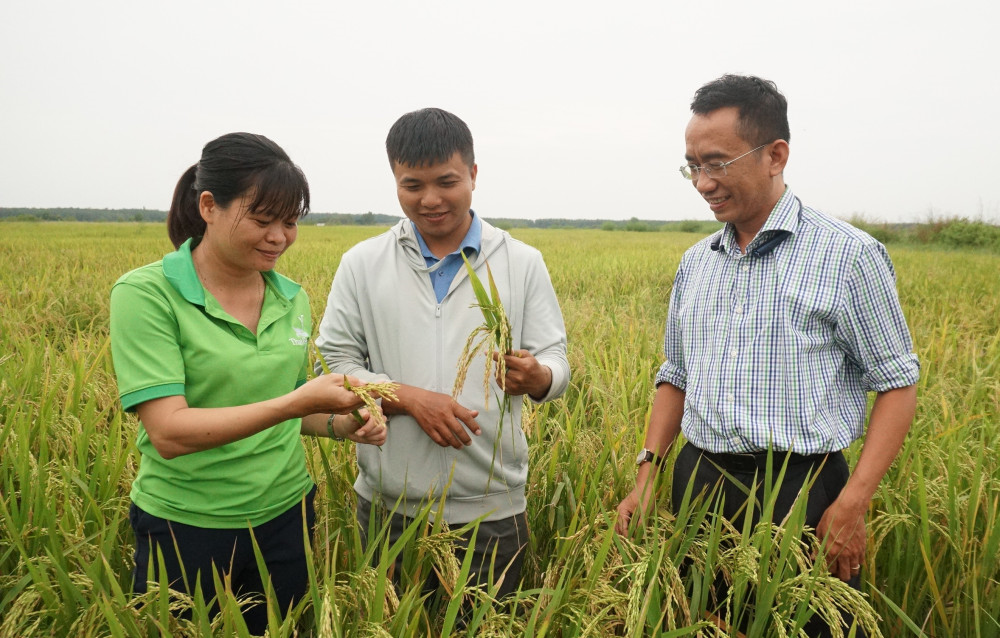
Greenhouses are a high-tech agricultural solution that helps farmers produce safe vegetables, stabilize output and adapt to climate change
Developing organic agriculture, reducing emissions
Tay Ninh has a diverse agricultural sector with many key crops such as rice, vegetables, fruit trees, sugarcane, cassava, etc. However, facing the challenge of declining soil quality, the risk of food insecurity, and increasing demands in demanding markets, the province has determined to switch to clean, organic, circular and emission-reducing production models. From the initial pilot models, organic production is spreading strongly and becoming the choice of many young farmers and dynamic cooperatives.
In vegetable production areas, many farming households, after a long time of dependence on chemical fertilizers and pesticides, have proactively converted to adapt. Mr. Le Van Toc, a farmer in Rach Kien commune, shared that the change stemmed from concerns about health and market demand.
“Previously, I used chemical fertilizers to make plants grow faster, but the soil was poor, and there were more and more pests and diseases. Since being instructed to switch to organic fertilizers, I initially encountered some difficulties, but when the vegetables achieved stable yields, higher selling prices, and customers trusted me, I knew I was on the right track,” Mr. Toc confided.
Not only vegetables, many areas growing custard apples, lemons, and dragon fruits in the province have also applied VietGAP and GlobalGAP processes and moved towards organic production. Despite strict technical requirements, people are increasingly aware that clean production is the top criterion.
%20s%E1%BA%A3n%20xu%E1%BA%A5t%20rau%20theo%20h%C6%B0%E1%BB%9Bng%20h%E1%BB%AFu%20c%C6%A1%2C%20gi%E1%BA%A3m%20t%E1%BB%91i%20%C4%91a%20ph%C3%A2n%20thu%E1%BB%91c%20h%C3%B3a%20h%E1%BB%8Dc.png)
Mr. Le Van Toc (Rach Kien commune) produces vegetables in an organic direction, minimizing fertilizers and chemicals
Thu Nguyen Cooperative (An Luc Long commune) was founded by Mr. Tran Hung Cuong. The cooperative gathers more than 100 members with more than 100 hectares, operating on the principle of "collective buying-collective selling", reducing risks and limiting the situation of being forced to lower prices by traders. In the early days, many members were still hesitant about the organic model because of the high costs and strict processes, but when witnessing the outstanding economic value, many households boldly converted.
Mr. Cuong shared, "Producing organic cannot be done overnight; it requires perseverance and discipline. But in return, clean agricultural products sell at a good price, protect people's health, and preserve land for future generations. When the world market requires cleanliness, as long as we do it right, we don't have to worry about the output of agricultural products."
The cooperative's organic dragon fruit is currently priced at 20,000-25,000 VND/kg and is being purchased by many Singaporean and Dutch businesses. In particular, the European market requires products to pass 500-700 testing criteria, with no chemical residues or residues. This is both a challenge and an opportunity for Tay Ninh to raise the standards of agricultural products to international standards.
%20ch%C4%83m%20s%C3%B3c%20thanh%20long.jpg)
Members of the Thu Nguyen Cooperative (An Luc Long commune) take care of dragon fruit according to the correct process and comply with "collective buying—collective selling."
In parallel with organic production, Tay Ninh promotes the development of circular agriculture to reduce input costs and limit environmental impact. Ms. Le Thi Hanh (farmer in Hoa Khanh commune) said that she previously encountered many difficulties in handling the amount of waste from her cows.
“In the past, the bad smell affected the neighbors, and the family also spent a lot of money on treatment. Since applying the circular model, cow manure is composted into organic fertilizer, wastewater is treated and then used to water grass. It is both environmentally clean and saves a lot of money,” Ms. Hanh shared.
Stories of conversion from the people themselves show that sustainable agriculture is no longer a strange concept but has become a practical direction, bringing clear benefits both economically and environmentally.
Green agriculture improves quality and increases value
The initial changes create an important foundation for Tay Ninh to build a long-term sustainable agricultural development strategy. The province possesses special advantages: fertile land, especially the large proportion of gray soil on ancient alluvium; a favorable climate; a stable water source thanks to Dau Tieng Lake; location bordering Cambodia and the gateway connecting the Southern Key Economic Zone. These are ideal conditions for Tay Ninh to develop multi-sector agriculture, from rice, sugarcane, cassava, and fruit trees to aquaculture and livestock.
In particular, Tay Ninh is currently the leading locality in the Southern region in high-tech livestock farming, with large-scale processing and export complexes for chicken, pork, beef, and milk, creating an important premise for developing a circular livestock farming model and reducing emissions. In addition, the province has formed many VietGAP, GlobalGAP and organic production areas, affirming its position as a high-tech agricultural center of the Southeast region.

Circular livestock farming model helps reduce emissions and protect the rural environment
According to Deputy Director of the Department of Agriculture and Environment Dinh Thi Phuong Khanh, in the coming time, Tay Ninh will orient its agricultural development based on four strategic pillars to create a comprehensive transformation in quality, efficiency and sustainability.
First of all, the province focuses on building a modern and professional agriculture, with the goal that by 2030, more than half of the cultivated area (equivalent to about 472,000 hectares) will apply high technology; in particular, key industries such as rice, fruit trees, cassava, sugarcane and vegetables all aim to achieve 57-90% of the area applying advanced technology. Livestock farming is also expected to be reorganized towards concentrated farms, ensuring 80-90% of the scale of pig and poultry herds and over 60% of cow herds operate according to biosafety standards.
At the same time, the province focuses on developing a sustainable production linkage system, aiming to form more effectively operating cooperatives, of which 70% apply high technology and at least 30% participate in stable consumption linkage chains, gradually building safe food supply chains with local imprints.
On that foundation, Tay Ninh promotes green and circular agriculture, striving for each new rural commune to have at least one practical circular economic model, while increasing the collection and recycling rate of agricultural by-products to about 80%.
The province also identifies digital transformation as an important driving force, with the goal of forming a synchronous agricultural database, widely applying electronic diaries and traceability solutions using QR codes or blockchain, helping businesses and cooperatives manage production more effectively, and meeting modern market requirements.

Farmers apply the “1 must, 5 reduce” process to help reduce costs and greenhouse gas emissions
“The province aims to build a sustainable agricultural production ecosystem, closely linking the environment and the economy. Tay Ninh will develop in the direction of clean, green, circular, and low emissions while promoting the application of high technology and digital transformation. When production changes, Tay Ninh agricultural products will be competitive enough to conquer the international market,” Ms. Dinh Thi Phuong Khanh emphasized.
Along with the technical orientation, the province focuses on developing chain linkages, attracting high-tech processing enterprises to stabilize output for farmers. This is also the foundation to promote people to change their mindset from individual production to value chain production.
However, to achieve the big goals, Tay Ninh has determined that it must continue to support farmers more strongly in the transition period, from training in organic techniques and training in biological processes to supporting investment capital for water-saving irrigation systems, biological products, and organic fertilizers. Farmers are still the center of the transition process; only when they change their mindset and farming methods will Tay Ninh agriculture develop sustainably.
Aiming for a green, modern, and responsible agriculture, Tay Ninh is striving to build a safe, circular, and low-emission production model, in line with global trends and meeting the increasingly high demands of the market. With the cooperation of people, cooperatives, businesses, and the government, Tay Ninh has every basis to become a bright spot in the Southeast region in sustainable agriculture, where people and the environment are placed at the center of all development policies./.
By Thanh Tung - Translated by Q. Thien
Source: https://baolongan.vn/huong-den-phat-trien-nong-nghiep-ben-vung-a207205.html
 Towards sustainable agricultural development
Towards sustainable agricultural development


%20s%E1%BA%A3n%20xu%E1%BA%A5t%20rau%20theo%20h%C6%B0%E1%BB%9Bng%20h%E1%BB%AFu%20c%C6%A1%2C%20gi%E1%BA%A3m%20t%E1%BB%91i%20%C4%91a%20ph%C3%A2n%20thu%E1%BB%91c%20h%C3%B3a%20h%E1%BB%8Dc.png)
%20ch%C4%83m%20s%C3%B3c%20thanh%20long.jpg)



